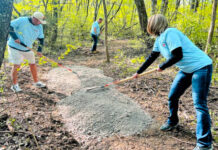Lawn and landscape crews travel from site to site throughout the workday—and when doing so, they assume the duty of keeping themselves and others safe while juggling time crunches, navigational challenges, and ongoing communications with the company and customer.
 Let’s face it: connected fleets tend to be more productive. Field service workers need to be able to communicate with team members and customers easily, navigate to work sites, and access workflow management solutions while on the go. Yet, from a safety perspective, this connectivity can be greatly problematic. Texting, calling, emailing, and other elements of distracted driving can greatly increase risk of accidents. And even though landscape field employees are working with potentially dangerous outdoor power equipment all day, distracted driving is becoming a more prevalent safety issue.
Let’s face it: connected fleets tend to be more productive. Field service workers need to be able to communicate with team members and customers easily, navigate to work sites, and access workflow management solutions while on the go. Yet, from a safety perspective, this connectivity can be greatly problematic. Texting, calling, emailing, and other elements of distracted driving can greatly increase risk of accidents. And even though landscape field employees are working with potentially dangerous outdoor power equipment all day, distracted driving is becoming a more prevalent safety issue.
From the moment crew members jump into trucks to when they arrive back at the end of the day, employers should be doing everything in their power to eliminate mobile device distractions. (This article details how Ruppert Landscape of Laytonsville, MD, has instituted a distracted driving policy that bans the use of cell phones—handheld or hands free—while operating a Ruppert vehicle or using a company-issued cell phone in a personal vehicle. They monitor this policy with dash cams installed in all their production vehicles.)
Another option besides dash cams is Contextual Mobility Management (CMM), a concept created by TRUCE Software. It allows certain mobile apps to remain accessible depending on the user’s context—such as situation, location, and time of day. When a crew member’s environment changes, such as when he or she sits down in the driver’s seat and starts up a work vehicle, so does the functionality of his/her mobile device.
By preventing unauthorized device use while behind the wheel through CMM, employers remove guesswork from device policy compliance while ensuring expectations are met. Unfortuntely, sometimes the consequences of distracted driving do not allow for the opportunity to improve.
Keeping field service crews safe and productive through CMM can help reduce financial, legal, and reputational risks through integration with existing practices and technologies. Not to mention, more work gets done.
Boyle is CEO of TRUCE Software, creators of a mobile management platform to provide flexible, contextual enforcement of mobile device policies, allowing companies to enable or temporarily suspend mobile apps based on work being performed, work location, or user/work group. Established in 2009, TRUCE Software is headquartered in Lisle, IL, with research and development in Baton Rouge, LA.
Do you have a comment? Share your thoughts in the Comments section below, or send an e-mail to the Editor at cmenapace@groupc.com.











![[VIDEO] Dickies®: Discover Workwear That’s Anything But Uniform](https://turfmagazine.com/wp-content/uploads/2023/06/1647663814-4b1a2a7742790a9b1e97a3b963477850192e1d6a9dfba9b07214a77bae25d6e3-d-218x150.jpg)






























![[VIDEO] Dickies®: Discover Workwear That’s Anything But Uniform](https://turfmagazine.com/wp-content/uploads/2023/06/1647663814-4b1a2a7742790a9b1e97a3b963477850192e1d6a9dfba9b07214a77bae25d6e3-d-324x160.jpg)